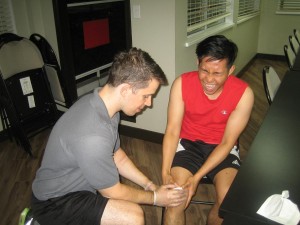The knee is considered as the biggest joint in the body and supports most of the body’s weight when running or walking. Since it takes most of the stress, it is prone to degeneration and injuries. Individuals over the age of 45 usually report some type of knee pain and the possibility to experience knee pain increases with age. Many issues that the elderly experience with their knees usually start with poor muscle development or lack of stretching that starts in their 50s.
Tendinitis
Patellar tendinitis involves the inflammation of the tendons that keep the kneecap in place. The individual can suffer from pain either below or above the kneecap. The type of tendinitis that usually occurs among individuals over 35 years old is located above the kneecap. Take note that this condition can be aggravated when the individual has weakened gluteal muscles or stiff hips. Both can add stress on the knee joint and quite common among the elderly who do not spend time on proper stretching. If you will register for first aid training, you will learn how to properly manage this condition.

Bursitis
It is important to note that the bursae are small-sized sacs that are filled with fluid that cushion the exterior of the knee joint. Due to repeated injury or increased age, the bursae can become inflamed and cause issues. An injury to bursae is quite common when the individual strikes the knee against a hard object such as a cabinet or desk. The symptoms include swelling, warmth, tenderness, redness, aching and pain while at rest and when using the stairs. If an infection is present, it can also be accompanied by fever.
Osteoarthritis
This is a degenerative form of arthritis that is quite common among individuals over 50 years old and progresses as one approach 70 years old. Osteoarthritis can cause varying degrees of pain when walking or standing. Individuals can experience stiffness, swelling and popping sound from the knee. Those who suffer from osteoarthritis can also experience loss of flexibility in the knee joint so that the range of motion is affected. These symptoms are due to the breakdown in the cartilage of the knee that occurs when in use and increasing age.
Meniscus tear
The menisci are C-shaped discs that support the fit between the thigh bone and shin bone. They help distribute the weight and absorb shock during running or walking. A meniscus tear can occur due to degeneration or injury. Since the meniscus does not receive any blood supply, the recovery can be difficult. Any degenerative tears on the meniscus are linked with the breakdown of the collagen fibers in the meniscus among the elderly.
Chondromalacia patella
It is important to note that this condition is quite common among the elderly who develop it due to arthritis in the kneecap. This triggers pain and soreness at the anterior part of the knee when sitting for long periods, using the stairs or moving up from a chair. The individual can also suffer from a grinding or hoarse sensation once the knee is drawn-out or straightened.
